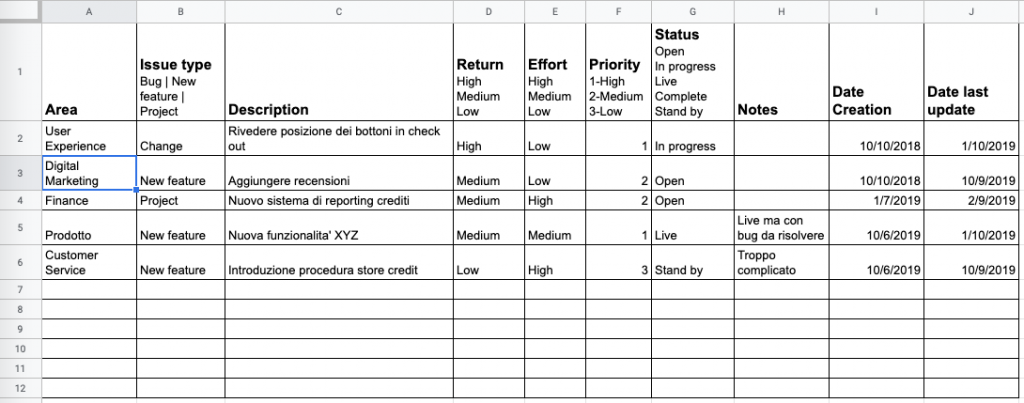- "If you haven't written it somewhere it's in your mind."
- "If something is occupying your mind, your head is not free."
- Everything unfinished must be captured in a tracking system reliable.
- You will log into this system regularly and update it.
The system David Allen has been talking about for me for years now is there issue list. To be precise, I think it was 2004 when I was working at Tod's that the IT Director taught me this simple method which I then continued over the years.

This is one of the key points to keep the mind free and responsive. Write down all the to-dos on a list (even a long one), this way you don't have to keep them in mind and you can use your mental resources to focus on what you are doing.
The model proposed by Allen in Getting Things Done is simple and effective. It consists of a methodology of time management, which does not focus on managing one's time but on how to handle the requests we receive efficiently.
1) In the face of a increasing number of external stimuli and requests for activities to be carried out by bosses and colleagues, we cannot think that we can organize everything only with the mind. But we need to “Collection buckets” where to put all the things to do and then look at these containers regularly.
The human mind has a limited capacity so if you keep too many things in mind we lose the clarity necessary to process information in the best way. This fact is scientifically proven but it is also extremely intuitive.
How can you concentrate on solving a problem and facing a situation with the right serenity if in the meantime you are trying not to forget other family or work commitments or deadlines that haunt you?
Allen's answer, to reach high productivity without stress, is to write all the to-dos in one or more containers, so that we have the certainty that all the to-dos are written there.
Buy the book on Amazon, direct link to the paper book >>
2) We have to trust this collector (s) (collection bucket) which will become our daily reference point for things to do. The binder could be for example Outlook tasks, an excel sheet, a project management program or a collaboration software. I personally use at least three Outlook tasks, the inbox for email, a task application that synchronizes with Google Calendar and Basecamp for cross-functional activities and projects.
Allen says the "containers" should be as few as possible. It will hardly be just one, but if they are too many then you have to check them all frequently and it becomes more difficult.
Trusting that we have captured all the to-do in writing out of our brains is the key in reduction of the level of stress: if we don't have to keep too many things in mind and we have a single system of collecting things to do we will be less stressed, more confident and more performing thanks to a freer mind.
3) How to make projects and activities progress even those where it is not clear what needs to be done? Here, too, the answer is simple, we must define an action, only one, that can set the activity in motion and make it progress even if only slightly. An action can also be very simple, such as making a phone call, sending an email, asking for a quote.
4) The fourth point is that the activities can be classified into Actionable (processable) and not. I will use the term here operable even if it is not correct but it renders the meaning better. Requests and actionable inputs can in turn be divided into shares with a maturity and assets with no maturity. Activities that have a deadline must be marked on a calendar with a reminder. Those that do not have a deadline should be put on a to-do list that we will look at daily (next actions). Requests and inputs that are not actionable should be archived. The same thing applies to the emails we receive.
5) When a request is received, and we understand what it is and is actionable, we must decide whether to do it immediately and postpone it. If the action takes two minutes or less it is better to do it immediately, if it takes longer it must be delegated or postponed.
6) The activities that are postponed can end up in the to do list (Next actions) or in the calendar.
7) Projects are complex activities that require ad hoc planning. Projects therefore cannot be managed through a simple next actions list and a calendar.
8) How to get started. The hardest part of applying the Getting Things Done method is getting started. Allen says that in order to start applying the methodology it takes a few hours, or even a couple of days, to resume all the projects and activities left open, describe them in a sentence and move them to the binder. Therefore you have to carve out the time to organize all the backward activities for the first time and do it in one go.
9) Why the classic daily to-do lists don't work: activity lists written on a calendar that if not done must be rewritten for the next day are a waste of time and are also demoralizing. The next action lists proposed by Allen do not need to be rewritten and are able to manage even the most time-sensitive deadlines.
Want to read Getting Things Done too?
Buy it on Amazon


